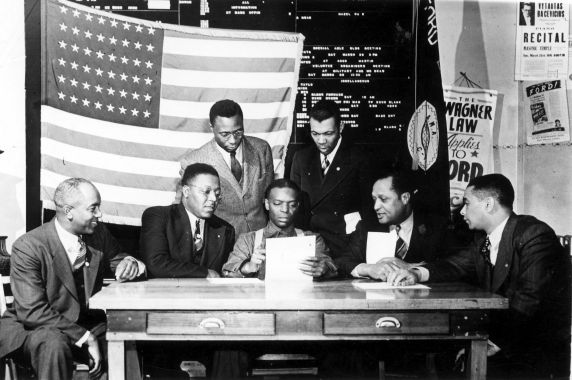The Michigan Black History Bibliography Index: An Invaluable Resource
In the mid 1970s, the Walter Reuther Library produced an invaluable source of information for numerous researchers that have walked through its doors - the Michigan Black History Bibliography Index. The index contains a wealth of information that does not exist anywhere else, providing researchers with connections to unique and often obscure sources. With this blog, a wider audience will become aware of its existence and value. The index is a four-drawer card file identifying sources that are key to understanding Black history in Michigan, and its hundreds of bibliographic references span from the 19th Century until the mid 1970s.
Researchers have put the index to valuable use. One of those is Professor Ula Taylor of the University of California, Berkeley. Following her research at the Reuther Library in 2007, she wrote a letter to Archivist Louis Jones extolling the importance of this resource. There, she maintains that, “I am still raving about you and the ‘black box of index cards’ to all of the librarians here at the University of California, Berkeley.” More recently, Ron Soodalter had this to say about this resource:
In 2015, I discovered the Michigan Black Bibliography Index while researching an article on a little-known civil rights case of the 1940s. Through the expert assistance of Louis Jones, I accessed files from the NAACP, as well as correspondences to and from Thurgood Marshall, all of which allowed me to assemble sufficient information for an accurate and informative piece. The article, which is scheduled to run in the June [2016] issue of The Progressive, would not have been possible without the information gleaned from the Index.
As Taylor and Soodalter found, many major moments reflecting the intersection between Michigan and African-American history are listed within. In addition to references to books and articles, references to other often hard to find but important resources include:
• Dissertations
• Theses
• Annotated bibliographies
• Reports
• Essays
• Pamphlets
• Research projects
• Broadsides
• And more
There are three distinct parts of the Bibliography. They include:
• Subject and personal name cards
• Numerically arranged cards listing the “items” cross referenced from the subject and personal name cards
• A key identifying the institution where the “items” are located
Detailed information on using this resource are located below.
Subject and Personal Name Cards
The Subject and Personal Name cards are located in a small black two-drawer card file on the top of those reading room file cabinets containing microfilm. They are in alphabetical order with the first drawer covering A-L and the second drawer covering M-Z. Interested researchers will use this two-drawer card file first. On each card, there is a number or multiple numbers that refer to cards (see Numbered Cards Listing the “Item(s)” below) containing the sources where researchers can find information regarding the subject or personal names of interest to them.
Numbered Cards Listing the “Item(s)”
These cards identify the actual sources where researchers may find information relevant to their research. They are located in a small black two-drawer card file located on top of the file cabinets in the reading room containing microfilm. They are in numerical order with the first drawer containing cards numbered 1-996 and the second drawer containing cards numbered 997-2093. One source is listed on each card. See the section titled, Key to Abbreviations Giving Location of Items for the location of items.
Key to Abbreviations Giving Location of Items
At the front of each card file is a key to abbreviations identifying the institution where items are located. With a few exceptions noted below, abbreviations are located at the bottom left hand corner of most of the Subject and Personal Name Cards. Since the WSU and Detroit Public Libraries were the starting points for the bibliography, one may assume that items having other abbreviation codes were not available at either of these libraries. Locations are not listed for most periodicals since their locations are usually easy to find independent of this bibliography. Theses and dissertations may be found at the university under whose direction they were prepared; if they are also available at other institutions closer to Detroit, that location is noted.
Caveats
This can be a tremendously helpful bibliography, pointing researchers in the direction of resources that they might not so easily find otherwise. That said, it can provide as many challenges and frustrations, as there are many instances where researchers will find it difficult to determine exactly where in a particular institution, an item is located.
If you happened to have used this resource during one of your visits to the Reuther Library, please contact archivist Louis Jones with your testimonials. They will be helpful as the Reuther Library seeks funding to create a digital version of the index that researchers can access without walking through the doors of the repository. You can reach Louis at louis.jones@wayne.edu.


 Reddit
Reddit Facebook
Facebook LinkedIn
LinkedIn